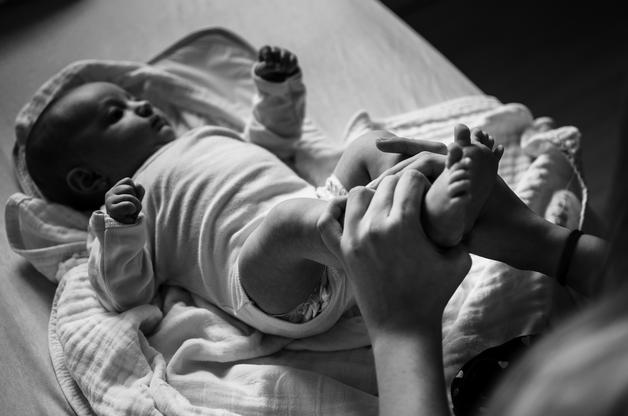Noticing a flat spot appearing on your baby’s head can feel like a jolt—sudden, surprising, anxiety-spiking. Yet, positional plagiocephaly is widely prevalent in infancy. Parents everywhere find themselves observing, assessing, and sometimes worrying about changes in the shape of their child’s skull. Why is this so common today? What does it mean medically? And most importantly—what can you do, right now, to help your baby thrive? Here, science meets real-life parenting with practical strategies and reassurance. The journey to understanding positional plagiocephaly will delve into origins, risk factors, signs and symptoms, medical research, and highly effective ways to support your child’s development, always grounded in recent pediatric expertise and everyday reality.
What is positional plagiocephaly?
Picture a baby lying peacefully on their back, head gently cushioned by the mattress—yet, over weeks, the occiput (the back part of the head) or one side starts to flatten. Positional plagiocephaly—often dubbed “flat head syndrome”—is this very scenario, a phenomenon drawing its name from the Greek words for “oblique” and “head.” The condition reflects an asymmetric flattening of an infant’s skull, usually not causing pain or distress, but creating variances in head contour, sometimes accompanied by subtle shifts in facial features, such as a misalignment of the ears or a discrepancy in forehead prominence.
Why now? Safe sleeping practices, specifically the widespread recommendation to place babies on their backs to reduce the risk of sudden infant death syndrome (SIDS), have genuinely been life-saving. However, they also foster the perfect conditions for external pressure to act on a flexible, still-developing cranium. Data now show that between 40% and 50% of healthy infants exhibit at least minor signs of positional plagiocephaly at some point within the first four months.
Crucially, not all skull shape variations point to flat head syndrome. Sometimes, health professionals need to distinguish between positional plagiocephaly and congenital conditions such as craniosynostosis—where early, abnormal fusion of skull sutures poses entirely different risks and may require surgical treatment. Here, a skilled clinical exam makes all the difference.
Causes and risk factors: Why do babies develop positional plagiocephaly?
You might ask: what leads to this flattening? The answer starts with the pliability of the infant skull—a quirk of human evolution, allowing for both brain growth and passage through the birth canal. Yet, the very softness that fuels early development leaves babies vulnerable to external pressure. Here’s where a multitude of factors step in:
- Prolonged pressure on one spot—think hours lying with the head turned in a single direction.
- Supine sleeping position: The “Back to Sleep” campaign dramatically reduced SIDS, but consistently positioning a baby on one spot increases the risk of developing a flat area.
- Prenatal factors: Babies squeezed in a small uterus (as in the last weeks of pregnancy), breech positions, or limited amniotic fluid sometimes present with flattening present at birth.
- Multiple births: Twins and higher-order multiples share precious little space both in utero and, at times, in neonatal units—upping the risk further.
- Congenital muscular torticollis—a condition where tightness in a neck muscle makes turning the head in one direction difficult, causing persistent pressure and reinforcing asymmetry.
- Prematurity: Preterm infants possess especially soft skulls and may spend long stretches lying with the head stationary due to medical needs.
- Extended time in baby gear—car seats, swings, bouncers: all limit free movement (note: actual travel is an exception, but lounging for hours should be minimized).
- No fault of caregiving: Even with attentive, loving care and diligent repositioning, some children develop positional plagiocephaly; parental vigilance should never be equated with blame.
Spotting the signs: Symptoms and how to recognize them
You turn your baby’s head during a diaper change and pause: is that spot at the back really flatter? Between six and eight weeks, the typical moment for visual changes to emerge, parental instinct picks up on subtle shifts. Watch for:
- Distinct flattening at the back or on one side of the skull—often corresponding to a “parallelogram” shape from above.
- Asymmetry: one ear may appear pushed forward, the opposite side of the forehead bulge subtly forward.
- A patch of persistent baldness—evidence of repetitive pressure and movement on a particular area.
- Subtle facial shifts: one cheek slightly fuller, one eye or eyebrow higher.
- A marked preference for turning the head one way or difficulty rotating fully—pointing toward possible congenital muscular torticollis.
Severity spans a spectrum: mild cases may need only brief relocation strategies, while moderate to severe flattening could prompt deeper intervention. Medical teams sometimes use the cranial vault asymmetry index (CVAI), a precise measurement of skull asymmetry, to grade the findings clinically.
Key point: pain or developmental delay is not part of the picture. Babies with positional plagiocephaly remain lively, playful, and engaged.
Long-term outcomes: Understanding the real consequences
It’s the big worry: could a flat spot signal underlying neurological risk? Research unanimously points to a primarily cosmetic influence—visible misalignments of the skull and sometimes the very soft tissues of the face. Numerous clinical investigations, including comprehensive studies referenced by organizations like the American Academy of Pediatrics, show that positional plagiocephaly does not correlate with impaired brain development or cognitive function. Early concerns about balance, learning, or fine motor setback faded under scrutiny; any slight delay often arises secondary to untreated underlying neck muscle tightness—again, a scenario reversible with rehabilitation.
Psychosocial impact? Persistent or severe skull asymmetry, while still rare, can affect self-image as children mature, particularly in a culture sensitive to physical appearance. The overwhelming majority, however, experience progressive improvement over months—and early action amplifies this trend.
Diagnosis: When is it time to seek advice?
A parent’s observation remains a central diagnostic tool. Pediatricians perform straightforward assessments of cranial shape, facial alignment, and—when necessary—use tape measures or specialized calipers to delineate the degree of asymmetry. In rare situations where craniosynostosis is a concern, additional imaging (such as ultrasound, CT, or MRI) might be ordered, but the vast majority of cases are clinical diagnoses, requiring no high-tech intervention.
Timing matters. The skull’s plasticity is highest in the first six months. Prompt identification of positional plagiocephaly allows simple interventions to have maximal effect, guiding bones gently back to their rounder shape.
Supporting your baby: Current medical strategies and daily adjustments
What should you do if you notice positional plagiocephaly? This is where proactive home approaches—accessible, empowering—make a genuine difference.
- Repositioning: Encourage your baby to turn their head both directions. Alternate positioning during sleep (for example, lay the baby’s feet at opposite ends of the crib each night, so they naturally look out toward room or wall), and switch arms during bottle-feeding or nursing.
- Tummy time: Place your baby on their stomach (while awake and supervised) for short, frequent sessions, increasing gradually. This not only takes pressure off the posterior skull but builds neck, back, and shoulder strength essential for future mobility.
- Varied play: Position toys, mobiles, and parents themselves on alternating sides to stimulate head rotation and encourage exploration in all directions.
- Reduced reliance on infant gear: Limit extended use of swings, car seats (while not in transit), and bouncers, creating more opportunity for free floor-based movement.
- Physical therapy: In cases of torticollis or marked restriction in neck movement, physiotherapy becomes the cornerstone of recovery. Experienced therapists can offer personalized stretches and exercises (often simple yet transformative).
- Osteopathic or manual therapy: Some families consider complementary approaches such as cranial osteopathy; evidence is evolving, but this is best seen as adjunctive to foundational repositioning and physiotherapy.
- Helmet therapy: Reserved for moderate-to-severe cases unresponsive to conservative treatments, cranial orthoses (custom-molded helmets) guide skull growth by redistributing pressure. Most protocols aim for 20–23 hours of daily wear, typically initiated between four and six months for optimal return. Efficacy is highest in this early window due to rapid cranial growth; later, bony structures consolidate, reducing malleability.
Surgery? Not for positional plagiocephaly. Only exceedingly rare diagnoses (like craniosynostosis or distinct craniofacial syndromes) might require operative intervention.
Timeline for improvement: What to expect
Correction unfolds over months, not days. Most families observe incremental reshaping within three to six months, often resolving by a child’s second birthday. Several principles optimize positive change:
- Early action works best: The younger the infant when strategies begin, the swifter and more notable the correction.
- Mild cases respond quickly: A matter of attentive daily routine, rather than long-term therapy.
- Consistency reigns supreme: Persistent attention to position, movement, and—if prescribed—helmet use produces the most reliable improvements.
Prevention: Everyday steps to minimize risk
Looking beyond correction, prevention blends seamlessly into daily caregiving routines:
- Always place your infant on their back to sleep, but alternate head orientation (left, right) between naps.
- Use a firm, flat mattress free of pillows, loose bedding, or plush toys.
- Skip sleep positioners, wedges, or nest “cradles.”
- Offer generous, varied tummy time and unrestricted movement on safe, supervised mats or blankets.
- Engage your baby in looking left and right, using your own face and brightly colored toys as inviting stimuli.
- Swap arms and positions while feeding, ensuring stimulation and head-turning both ways.
- Address any early signs of neck stiffness—through professional evaluation and, if necessary, therapy.
Consistency weaves small changes into powerful foundations, decreasing both the incidence and severity of positional plagiocephaly.
Synthesizing the latest medical insights: What research teaches us
Longitudinal data consistently highlight a benign, self-limiting pattern for most positional plagiocephaly cases. Physical therapy and repositioning shine as first-line tools, especially when introduced before four months. Helmet therapy—while sometimes cutting correction time in moderate or severe cases—has similar long-term outcomes to simple daily positional modifications for many infants. Satisfaction rates soar with prompt, tailored intervention, and evidence underscores that parents play a pivotal role in gentle correction—never as agents of harm, always as partners in health.
No contemporary research substantiates theories linking isolated flat head syndrome to alterations in cognitive capacity, behavioral problems, or independent developmental delay.
Debunking frequent myths: Clarifying what positional plagiocephaly isn’t
Several ideas linger and deserve swift challenge:
- Positional plagiocephaly does not signal brain damage or developmental delay.
- Safe sleep, even if it increases mild skull flattening, remains essential—protecting infants from SIDS is non-negotiable.
- Helmets are not a universal solution; most families see improvement with repositioning and guided therapy alone.
- Many cases resolve entirely with normal growth and movement—intervention optimizes, but biology helps, too.
- Parental care cannot “cause” this condition; it emerges from the beautiful, sometimes unpredictable, interaction between infant physiology, environment, and developmental stage.
If you ever feel uncertainty, a seasoned health professional can provide clarity and a tailored plan matched to your child’s precise needs.
Resources and expert support
Your pediatrician should serve as your first port of call—offering both expertise and reassurance. In scenarios requiring further guidance, craniofacial clinics and teams of pediatric neurologists, orthotists, and physiotherapists create a safety net for assessment and intervention, including helmet fitting if warranted.
For families seeking credible information, well-established hospital resources and pediatric health associations (like the American Academy of Pediatrics or Royal College of Paediatrics and Child Health) provide evidence-based articles and videos, while support groups—both local and digital—offer opportunities for shared experience, empathy, and advice exchange. Professional follow-up and regular check-ins anchor the journey, sustaining confidence and empowering decision-making at every turn.
Key Takeaways
- Positional plagiocephaly is extremely common and primarily influences appearance, not brain health or function.
- Early, gentle, and consistent strategies—including supervised tummy time, frequent repositioning, and professional physical therapy—yield excellent results for most babies.
- Custom helmets have their place for specific moderate to severe presentations, but the majority of infants improve naturally over time, with or without formal devices.
- Blame plays no part—multiple factors outside a parent’s direct control contribute to this process, and supportive resources are at hand.
- Should you notice emerging asymmetry or concerns about your baby’s head shape or movement, timely evaluation and simple interventions provide both reassurance and powerful results.
- Expert guidance, up-to-date resources, and day-to-day parenting practices together shape strong, confident outcomes—for your child and for you.
Looking for personalized pediatric support, health questionnaires, or tailored advice? Download the Heloa app for evidence-based health tools and peace of mind as you accompany your baby’s remarkable journey.
Questions Parents Ask
Can positional plagiocephaly correct itself without treatment?
In many cases, slight flattening can improve gradually as your baby grows and gains more head control. Once babies start to move more—rolling, sitting, crawling—they naturally relieve the constant pressure on one spot of the skull. Gentle, everyday adjustments like encouraging varied play positions and supervised tummy time support this natural reshaping. If you have any doubts, a health professional can help you find the best approach for your child’s needs.
Does positional plagiocephaly cause pain or discomfort for my baby?
Rassurez-vous, positional plagiocephaly itself does not cause pain or discomfort for your baby. Most infants with this condition remain just as cheerful, active, and curious as any other child. They continue to learn, play, and develop normally. Sometimes, associated neck stiffness (known as torticollis) might make head movement uncomfortable, but the flat spot alone isn’t painful.
When should I consider consulting a specialist for my baby’s head shape?
You can always reach out to your pediatrician for reassurance if you notice any changes in your baby’s head shape. It may be helpful to seek specialist advice if the flattening seems to be getting worse after trying home repositioning, or if you notice your baby has difficulty moving their head, a strong preference for one side, or any other developmental concern. Pediatric teams and craniofacial specialists can offer tailored guidance so you feel supported at every step.
Further reading:









